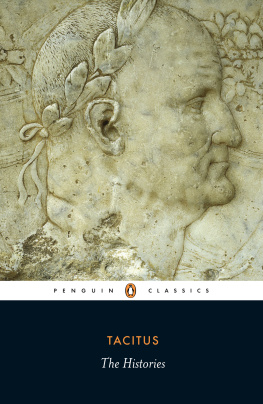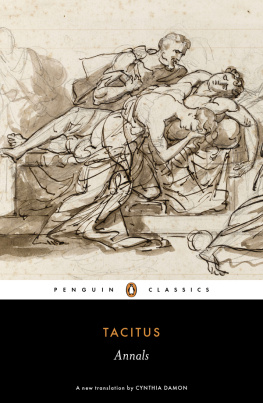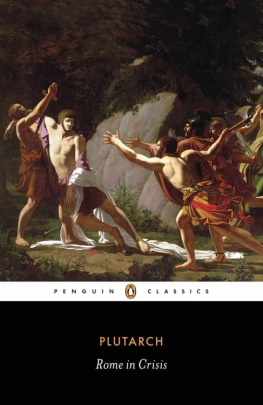TACITUS
The Histories
Translated by KENNETH WELLESLEY
Revised with a new Introduction by RHIANNON ASH
PENGUIN BOOKS
PENGUIN CLASSICS
Published by the Penguin Group
Penguin Books Ltd, 80 Strand, London WC2R 0RL , England
Penguin Group (USA) Inc., 375 Hudson Street, New York, New York 10014, USA
Penguin Group (Canada), 90 Eglinton Avenue East, Suite 700, Toronto, Ontario, Canada M4P 2Y3
(a division of Pearson Penguin Canada Inc.)
Penguin Ireland, 25 St Stephens Green, Dublin 2, Ireland
(a division of Penguin Books Ltd)
Penguin Group (Australia), 250 Camberwell Road, Camberwell, Victoria 3124, Australia
(a division of Pearson Australia Group Pty Ltd)
Penguin Books India Pvt Ltd, 11 Community Centre, Panchsheel Park, New Delhi 110 017, India
Penguin Group (NZ), 67 Apollo Drive, Rosedale, North Shore 0632, New Zealand
(a division of Pearson New Zealand Ltd)
Penguin Books (South Africa) (Pty) Ltd, 24 Sturdee Avenue, Rosebank, Johannesburg 2196, South Africa
Penguin Books Ltd, Registered Offices: 80 Strand, London WC2R 0RL , England
www.penguin.com
This translation first published 1964
Reprinted with revisions 1972, 1975, 1986, 1990, 1991, 1992, 1993, 1995
This revised edition first published in Penguin Classics 2009
Translation copyright Kenneth Wellesley, 1964, 1972, 1975, 1986, 1990, 1991, 1992, 1993, 1995
Revisions to the translation, Introduction and editorial material copyright Rhiannon Ash, 2009
All rights reserved
The moral right of the translator and editor has been asserted
Except in the United States of America, this book is sold subject to the condition that it shall not, by way of trade or otherwise, be lent, re-sold, hired out, or otherwise circulated without the publishers prior consent in any form of binding or cover other than that in which it is published and without a similar condition including this condition being imposed on the subsequent purchaser
ISBN: 978-0-14-194248-3
PENGUIN

CLASSICS
THE HISTORIES
TACITUS , born in about AD 56 in southern Gaul (modern Provence) under the emperor Nero, was probably the son of an equestrian. He was in Rome by 75, training as an orator. As Tacitus himself concedes at the opening of the Histories, his own political career flourished under the Flavian emperors, Vespasian (6979), Titus (7981) and Domitian (8196). It was not until after the dynasty had ended that Tacitus set in motion his career as a writer. In quick succession, he published the Agricola (a biography of his father-in-law) and the Germania (an ethnographical study of the peoples of Germany), both in 98. There followed (some time early in the second century) his Dialogue about Orators. Today Tacitus is best known as a historian. His debut in the genre, The Histories, is a gripping narrative of turbulent events from Galbas accession in 69 until Domitians assassination in 96. His next work, The Annals, moves further back in time to cover the Julio-Claudian emperors from Tiberius (1437) to Nero (5468). Neither narrative survives complete, but both preserve Tacitus uniquely compelling historical voice and offer a chilling denunciation of the corrupting force of power in the Roman empire. His strong moralizing ethos, together with brilliant techniques of literary artistry, combine to create a powerful and enduring portrait of imperial Rome at its best and its worst. The culmination of Tacitus public career was when he won the prestigious post of proconsul of Asia (112/13). He died at some point after 115 and probably lived into the reign of Hadrian (11738), but there is no evidence for his later life or the date of his death.
KENNETH WELLESLEY was, until 1981, Reader in Humanity (Latin) at the University of Edinburgh. He contributed a number of papers to learned journals on various aspects of Roman history and literature and was also engaged in a textual, literary and historical study of the Histories of Tacitus. Most of the sites mentioned in the Histories were familiar to him from personal knowledge, and he was co-editor of the standard Teubner text of Tacitus (Leipzig). He died in 1995.
RHIANNON ASH is Fellow and Tutor in Classics at Merton College, Oxford. After taking an MA in Medieval Latin at the University of Toronto, she returned from Canada to Oxford, where she wrote a doctorate on Tacitus Histories. Her publications include Ordering Anarchy: Leaders and Armies in Tacitus Histories (1999) and a commentary, Tacitus Histories Book II (2007), in the Cambridge Greek and Latin Classics series. She has also written articles on Naevius, Pliny the Younger, Pliny the Elder, Suetonius and Plutarch.
Chronology
Tacitus Histories and the parallel tradition offer a wealth of information about the detailed chronology of the civil wars, but some dates are more secure than others, and critics still debate points of detail. A helpful study of this whole topic is C. L. Murison, Galba, Otho and Vitellius: Careers and Controversies, Spudasmata 52 (Hildesheim, Zurich, New York 1993), some references to which are cited below. What follows here is intended to offer some guidance, but inevitably absolute certainty is impossible. References to the relevant sections of Tacitus Histories are included (where possible) in brackets. You will notice that the real chronological order of events does not always cohere with Tacitus presentation of the material in the narrative and the differences are often instructive about his historiographical techniques.
Events of the Civil War
AD 68
April (early) Galba, governor of Hispania Tarraconensis, sets himself up as a challenger to the emperor Nero.
May (middle) At Vesontio in central Gaul, Verginius Rufus, governor of Upper Germany, successfully puts down the revolt of Vindex, governor of Gallia Lugdunensis, though he later claims that his troops acted spontaneously (1.16, 1.51).
9 or 11 June Nero commits suicide (1.4).
16 June Galba is declared emperor in Spain.
July (middle) Galba sets off from Spain across the Pyrenees, through southern Gaul, across the Cottian Alps and down to Rome (1.6).
September (early) Fonteius Capito, governor of Lower Germany, allegedly rebels and is murdered by the legionary commanders, Cornelius Aquinus and Fabius Valens (1.7).
September (late) or October Galba arrives in Rome after massacring troops at the Milvian Bridge (1.6).
November (end) Vitellius, appointed by Galba, arrives in Lower Germany as governor (1.9, 1.52).
AD 69
1 January The troops in Upper Germany revolt (1.12, 1.556).
23 January The troops in Upper and Lower Germany go over to Vitellius (1.57).
c. 9 January A letter arrives in Rome from the procurator of Belgica, Pompeius Propinquus, to inform the emperor Galba that the legions of Upper Germany have broken their oath of allegiance (1.12).
10 January Galba adopts Piso as his successor (1.18).
12/13 January Vitellius general Fabius Valens sets off southwards from Colonia Agrippinensium on his mission to cross the Alps (1.626; Murison, pp. 8690).
15 January Otho is declared emperor in Rome and recognized by the praetorian guard (1.2735). Galba, Piso and Vinius are murdered (1.413); Otho is recognized as emperor by the senate (1.47).
January (end) Vespasians son Titus, having left Judaea, reaches Corinth in Greece, hears that Galba is dead and so aborts his mission to offer congratulations (2.1).
















 CLASSICS
CLASSICS